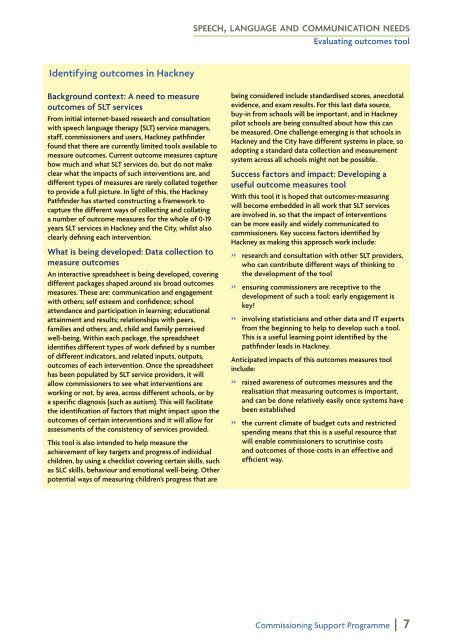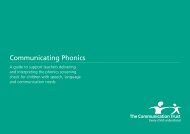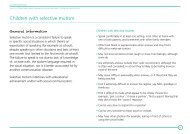Speech, language and communication needs: Evaluating outcomes ...
Speech, language and communication needs: Evaluating outcomes ...
Speech, language and communication needs: Evaluating outcomes ...
You also want an ePaper? Increase the reach of your titles
YUMPU automatically turns print PDFs into web optimized ePapers that Google loves.
speech, <strong>language</strong> <strong>and</strong> <strong>communication</strong> <strong>needs</strong><br />
<strong>Evaluating</strong> <strong>outcomes</strong> tool<br />
Identifying <strong>outcomes</strong> in Hackney<br />
Background context: A need to measure<br />
<strong>outcomes</strong> of SLT services<br />
From initial internet-based research <strong>and</strong> consultation<br />
with speech <strong>language</strong> therapy (SLT) service managers,<br />
staff, commissioners <strong>and</strong> users, Hackney pathfinder<br />
found that there are currently limited tools available to<br />
measure <strong>outcomes</strong>. Current outcome measures capture<br />
how much <strong>and</strong> what SLT services do, but do not make<br />
clear what the impacts of such interventions are, <strong>and</strong><br />
different types of measures are rarely collated together<br />
to provide a full picture. In light of this, the Hackney<br />
Pathfinder has started constructing a framework to<br />
capture the different ways of collecting <strong>and</strong> collating<br />
a number of outcome measures for the whole of 0-19<br />
years SLT services in Hackney <strong>and</strong> the City, whilst also<br />
clearly defining each intervention.<br />
What is being developed: Data collection to<br />
measure <strong>outcomes</strong><br />
An interactive spreadsheet is being developed, covering<br />
different packages shaped around six broad <strong>outcomes</strong><br />
measures. These are: <strong>communication</strong> <strong>and</strong> engagement<br />
with others; self esteem <strong>and</strong> confidence; school<br />
attendance <strong>and</strong> participation in learning; educational<br />
attainment <strong>and</strong> results; relationships with peers,<br />
families <strong>and</strong> others; <strong>and</strong>, child <strong>and</strong> family perceived<br />
well-being. Within each package, the spreadsheet<br />
identifies different types of work defined by a number<br />
of different indicators, <strong>and</strong> related inputs, outputs,<br />
<strong>outcomes</strong> of each intervention. Once the spreadsheet<br />
has been populated by SLT service providers, it will<br />
allow commissioners to see what interventions are<br />
working or not, by area, across different schools, or by<br />
a specific diagnosis (such as autism). This will facilitate<br />
the identification of factors that might impact upon the<br />
<strong>outcomes</strong> of certain interventions <strong>and</strong> it will allow for<br />
assessments of the consistency of services provided.<br />
This tool is also intended to help measure the<br />
achievement of key targets <strong>and</strong> progress of individual<br />
children, by using a checklist covering certain skills, such<br />
as SLC skills, behaviour <strong>and</strong> emotional well-being. Other<br />
potential ways of measuring children’s progress that are<br />
being considered include st<strong>and</strong>ardised scores, anecdotal<br />
evidence, <strong>and</strong> exam results. For this last data source,<br />
buy-in from schools will be important, <strong>and</strong> in Hackney<br />
pilot schools are being consulted about how this can<br />
be measured. One challenge emerging is that schools in<br />
Hackney <strong>and</strong> the City have different systems in place, so<br />
adopting a st<strong>and</strong>ard data collection <strong>and</strong> measurement<br />
system across all schools might not be possible.<br />
Success factors <strong>and</strong> impact: Developing a<br />
useful outcome measures tool<br />
With this tool it is hoped that <strong>outcomes</strong>-measuring<br />
will become embedded in all work that SLT services<br />
are involved in, so that the impact of interventions<br />
can be more easily <strong>and</strong> widely communicated to<br />
commissioners. Key success factors identified by<br />
Hackney as making this approach work include:<br />
»»<br />
research <strong>and</strong> consultation with other SLT providers,<br />
who can contribute different ways of thinking to<br />
the development of the tool<br />
»»<br />
ensuring commissioners are receptive to the<br />
development of such a tool: early engagement is<br />
key!<br />
»»<br />
involving statisticians <strong>and</strong> other data <strong>and</strong> IT experts<br />
from the beginning to help to develop such a tool.<br />
This is a useful learning point identified by the<br />
pathfinder leads in Hackney.<br />
Anticipated impacts of this <strong>outcomes</strong> measures tool<br />
include:<br />
»»<br />
raised awareness of <strong>outcomes</strong> measures <strong>and</strong> the<br />
realisation that measuring <strong>outcomes</strong> is important,<br />
<strong>and</strong> can be done relatively easily once systems have<br />
been established<br />
»»<br />
the current climate of budget cuts <strong>and</strong> restricted<br />
spending means that this is a useful resource that<br />
will enable commissioners to scrutinise costs<br />
<strong>and</strong> <strong>outcomes</strong> of those costs in an effective <strong>and</strong><br />
efficient way.<br />
Commissioning Support Programme | 7

















